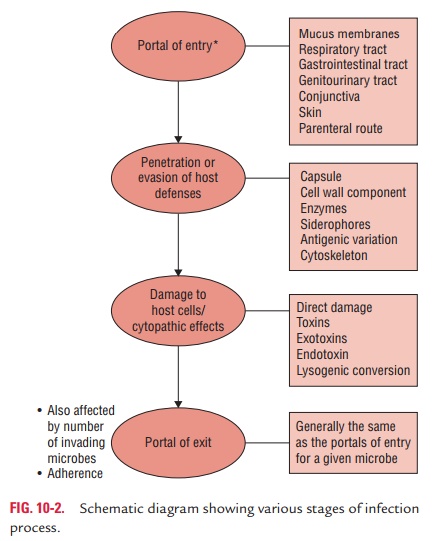Chapter: Microbiology and Immunology: Microbial Pathogenesis
Entry of Organisms and Evasion of Local Defenses - Stages of Pathogenesis of Infections
Entry of Organisms and Evasion of
Local Defenses
Skin, mucus, ciliated epithelium, and secretions containing
antibacterial substances (e.g., lysozyme) are the natural barriers of the human
and animal hosts that prevent microbial entry. However, these barriers are
sometimes broken (e.g., a break in the skin, an ulcer in the intestine, or a
tumor, etc.), thereby allowing the entry of microbes into the host (Table
10-5). On entry, the microbes spread through blood circulation to other sites
in the body (Fig. 10-2).

Skin: The stratified squamous
epithelium of the skin with itssuperficial cornified anucleate layers is a
simple and efficient mechanical barrier to prevent microbial invasion.
Organisms gain access to the underlying tissues only by breaks or by way of
hair follicles, sebaceous glands, and sweat glands that traverse the stratified
layers.

The surface of the skin
continuously desquamates and thereby tends to shed contaminating organisms. The
skin also inhibits the growth of most extraneous microorganisms due to its low
moisture, low pH, and the presence of substances with an antibacterial
activity.
Mucus: Viscous mucus secreted by
goblet cells protects theepithelium lining the respiratory and gastrointestinal
tracts and urogenital system. Microorganisms become trapped in the mucus layer
and may be swept away before they reach the epithelial cell surface. Secretory
IgA, secreted into the mucus, and other secreted antimicrobials (such as
lysozyme and lacto-ferrin) facilitate this cleansing process.
Ciliated epithelial cells: These cells constantly move
themucus away from the epithelial surfaces. For example, mucus in the
respiratory tract—particles larger than 5 mm are washed and trapped in the mucus. Similarly,
the multilayered transi-tional epithelium of the urinary tract uses the
flushing effect of urine, and its relatively low pH acts as an additional
defense mechanism to limit microbial entry and growth.
Secretions: The high level of
hydrochloric acid and gastricenzymes in the normal stomach kills many ingested
bacteria. Others are susceptible to pancreatic digestive enzymes or to the
detergent effect of bile salts.
Related Topics